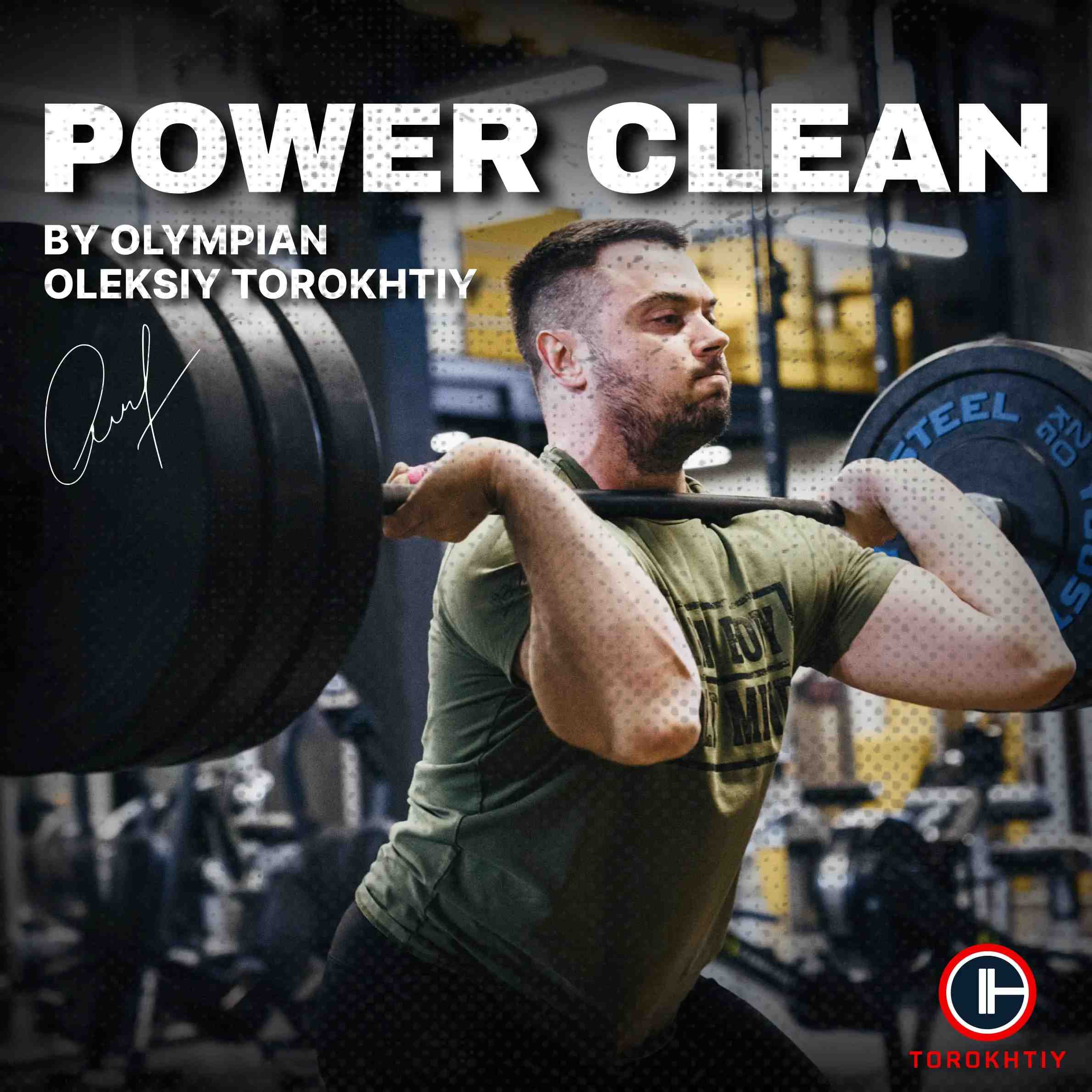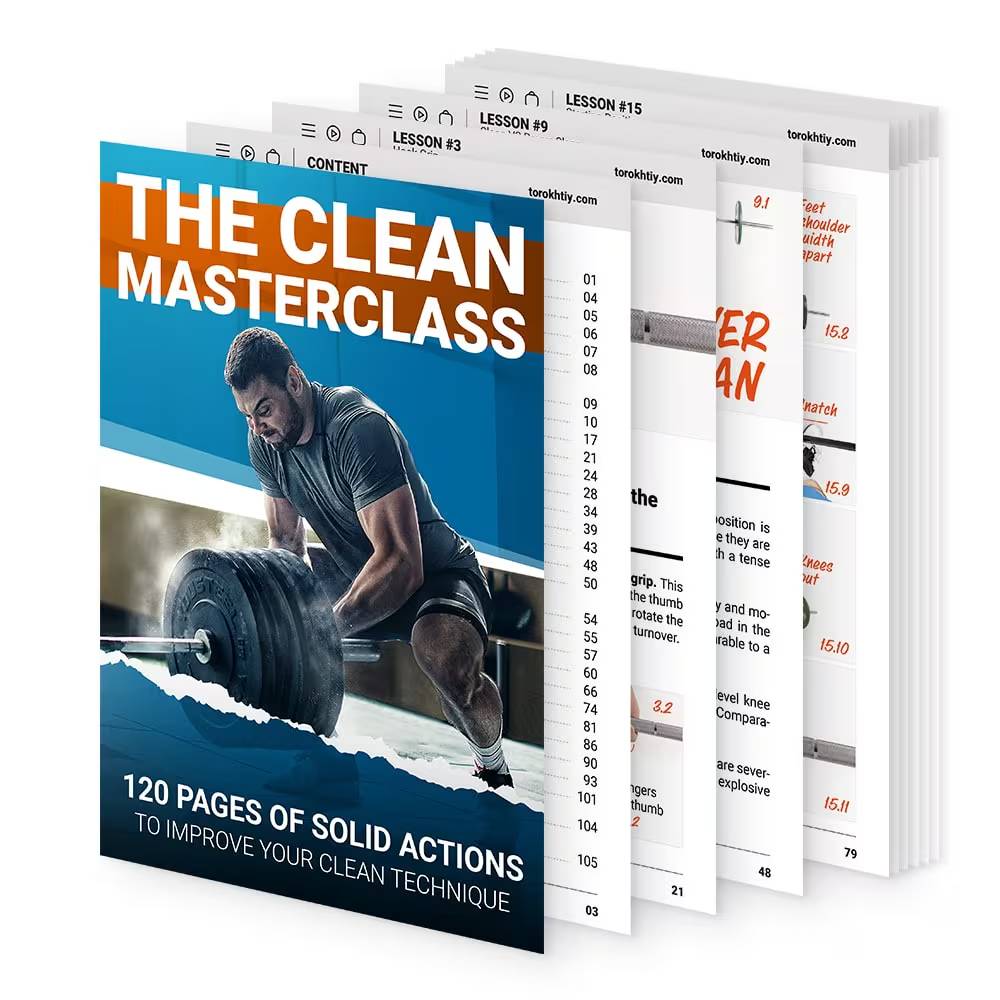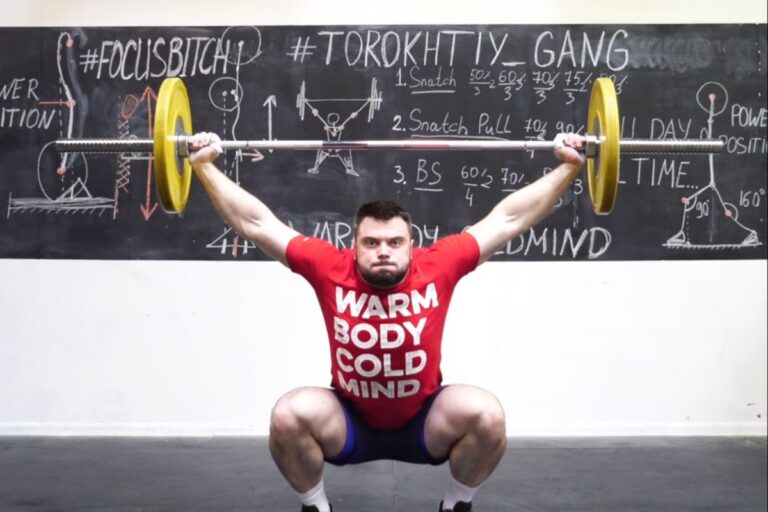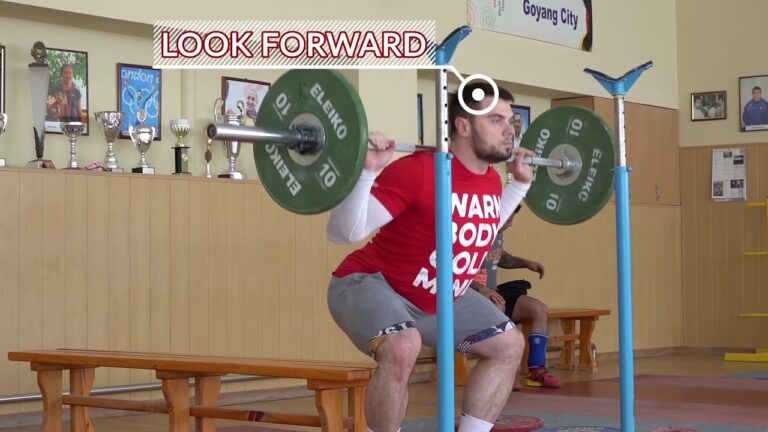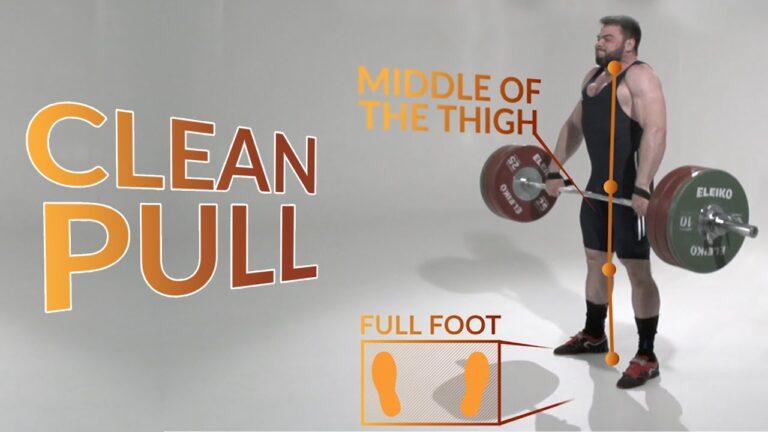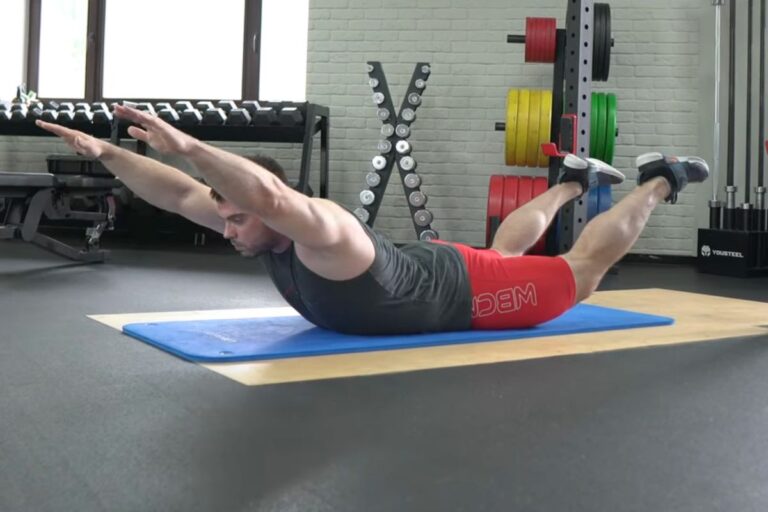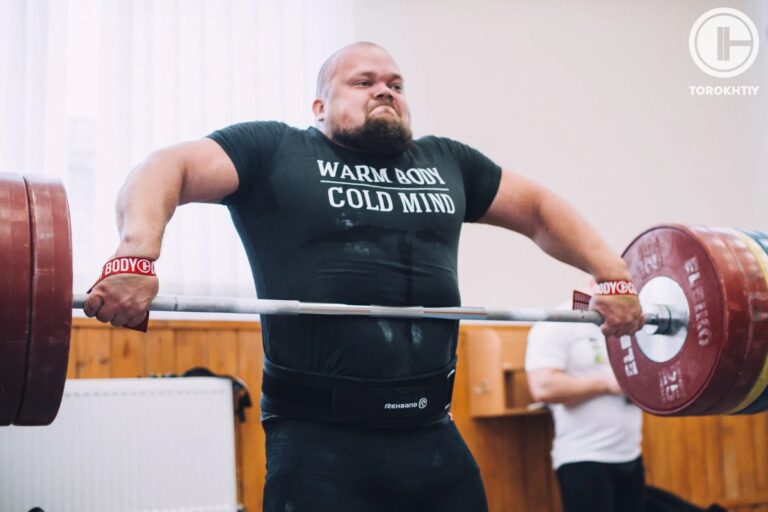Power Clean Exercise: How To, Benefits & Variations
The power clean is one of the high-intensity movements in Olympic weightlifting often performed by seasoned athletes, Olympic weightlifters, and regular gym attendees who strive to improve the whole-body explosive strength and power. Despite the movement takes only several seconds to be performed, it requires enough skills and proper technique.
What is a power clean? The power clean is a weightlifting exercise. It involves lifting a barbell from the floor to the shoulders in a single explosive movement.
It starts in a low position with the barbell on the floor, gripping the bar with an overhand grip, and then explosively extending the legs and hips while pulling the bar upward. The lifter then quickly drops under the bar and catches it in a front rack position as high as possible with the elbows up and the bar resting on the front of the shoulders.
Thus, it’s crucial to learn each Power Clean phase correctly at the very beginning as it can be difficult to correct it later, and also start with light l1oads to get assured that you have the proper form and condition.
As a regular training exercise, a Power Clean is effective in developing explosiveness, improving body composition, and general coordination and mobility.
Helpful Video Demonstrations on How to Do Power Clean
Step-by-step Visual Guide (Time: 2 minutes)
Video Demonstration and Small Tips (Time: 1 minute)
The Main Muscles Used in Power Clean
The Power Clean exercise involves a number of muscle groups working together in a coordinated manner to perform the movement. The primary muscles targeted by the Power Clean include:
1. Glutes and Hamstrings
These are the main muscle groups responsible for extending the hips and generating power to lift the barbell off the floor.
2. Quadriceps
The quadriceps are also heavily involved in the initial phase of the lift, helping to extend the knees and generate force.
3. Lower Back
The muscles of the lower back play an important role in stabilizing the spine and keeping the torso in the correct position throughout the movement.
4. Trapezius
The trapezius muscles in the upper back and shoulders are involved in shrugging the shoulders and pulling the barbell upward during the lift.
5. Deltoids
The deltoids, or shoulder muscles, help to stabilize the shoulders and keep the barbell close to the body during the lift.
6. Forearms
The forearms play an important role in gripping the barbell and maintaining control throughout the movement.
This is a quick answer to the question of what muscles do power clean work.
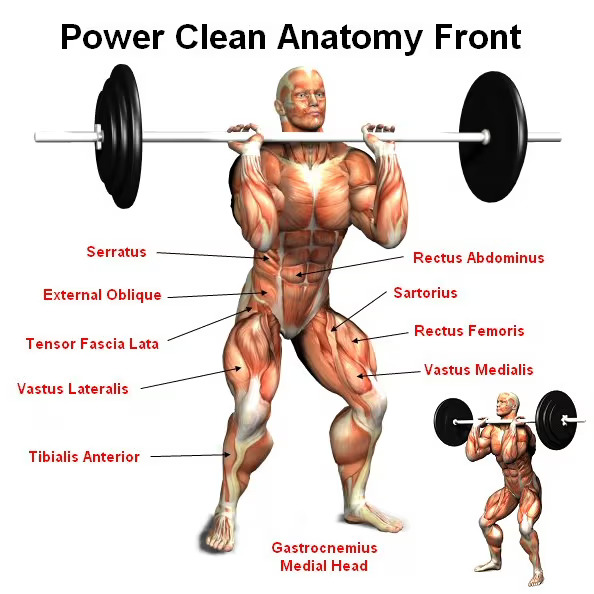
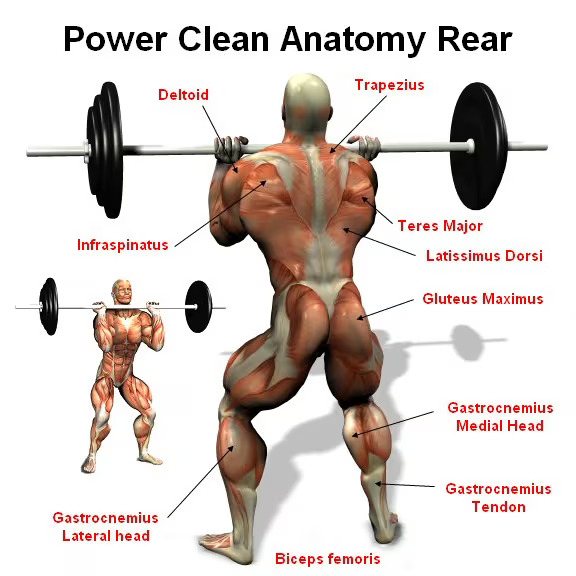
How to Do a Power Clean – Phases and Technique
1. Start Position
(0:10-0:40 on the video above)
Set your feet shoulder-width apart from the bar. It’s a typical Soviet school standard. Still, the Chinese recommend choosing a foot position that is comfortable for jumping up. You should try out both options.
The bar projection should be just above the mid-foot. In other words, while standing straight, an athlete should see the bar on the mid-foot. Also, there can be some shin lean in the starting position, we will talk about it a bit later. The feet and knees should be 5-10% out to give some room for the trunk between the hips. The center of gravity should be on the mid-foot, some coaches even recommend moving it a bit closer to the heel. Now, when your lower body starting position is ready, you should grab the bar.
Grip the bar with a hook grip and keep your arms straight. What grip is correct for the power clean? Your grip should be around a fist wider than the shoulders. It is known as the clean grip and has several benefits:
– this width is enough to keep the arms straight while grabbing the bar with the knees out;
– this width is enough to comfortably switch the bar to the front rack position;
– in the pull, this width allows to hold the bar as close to the thigh as possible and maximize power in the explosion.
Your arms stay straight during this phase, your feet should be flat on the floor. Remember this, since the start position is the key to a successful lift. Make sure there’s a vertical line from the barbell to your shoulders. Your lower back should be straight.
An athlete should raise the head by 45˚, open the chest and arch the back. Bent hip, knee, and ankle joints so that you can set up with the bar on the platform. Shoulders must be in line with the knees, arms straight and relaxed. The body angle depends on the arm, trunk, and leg length so don’t worry about copying someone else.
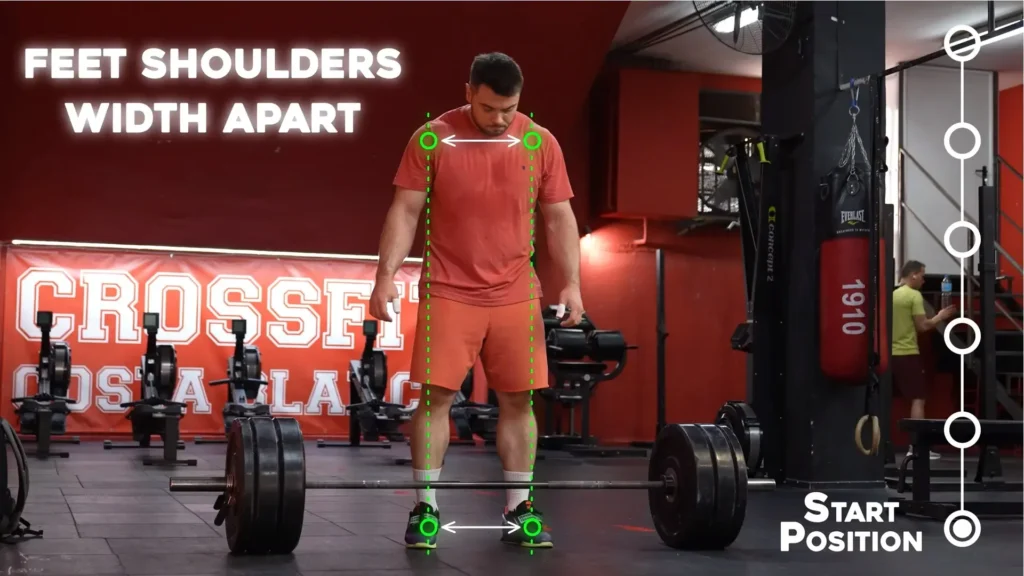
2. 1st Pull
(0:40-1:03 on the video above)
As you lift the bar, keep it close and maintain the vertical line. Your arms stay straight during this phase. What’s important, keep your feet flat on the floor: this will help you to stay balanced and generate power.
The secret of the proper pull is approaching it as pushing against the platform rather than pulling the bar. It is important to move your hips and shoulders simultaneously. As a result, you can keep balance and the upper body position.
How to keep the bar close to the body in the power clean? Throughout the whole movement, an athlete should maintain the highest proximity to the shin, thigh, and trunk. In order to do this, you should:
– keep shoulders above the knees;
– control the center of gravity on the mid-foot;
– stay flat-footed up to the explosion;
– press the bar towards yourself by involving lateral back muscles.
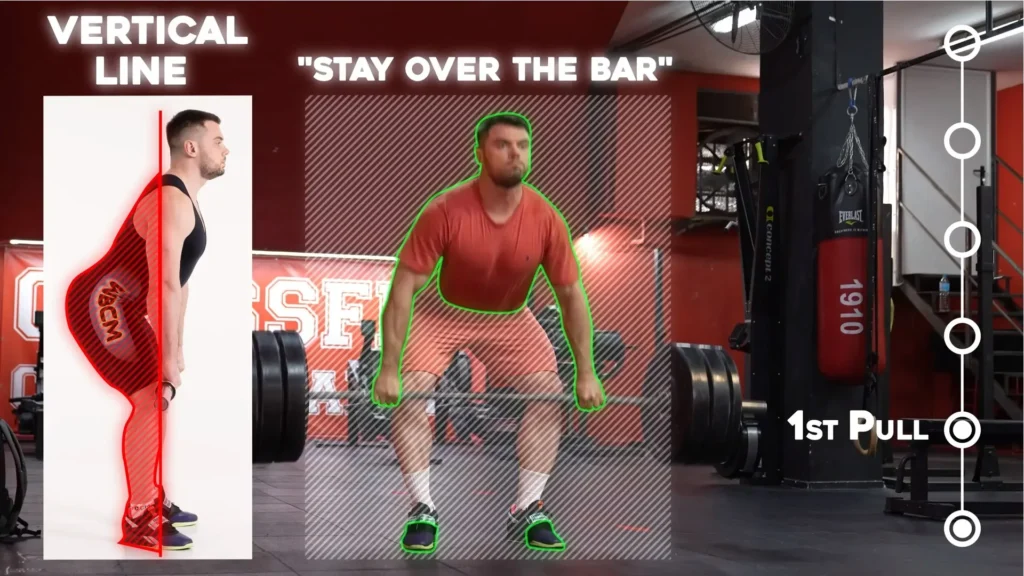
3. 2nd Pull
(1:03-1:18 on the video above)
You should still stay over the bar and keep your feet flat until the bar reaches the point of contact. From here you explode up by extending your body to add a momentum to the bar.
The Power Position is when the bar reaches the middle of the thighs or slightly higher, an athlete starts the explosion – the powerful knee, hip, and ankle extension. At this moment, one passes the vertical impulse from the thighs to the bar. At this point, athletes usually spring up from the mid-foot as it is one of the most optimal ways to accumulate maximum vertical power.
Why the mid-foot? Because it is the most stable squat point for EVERYONE
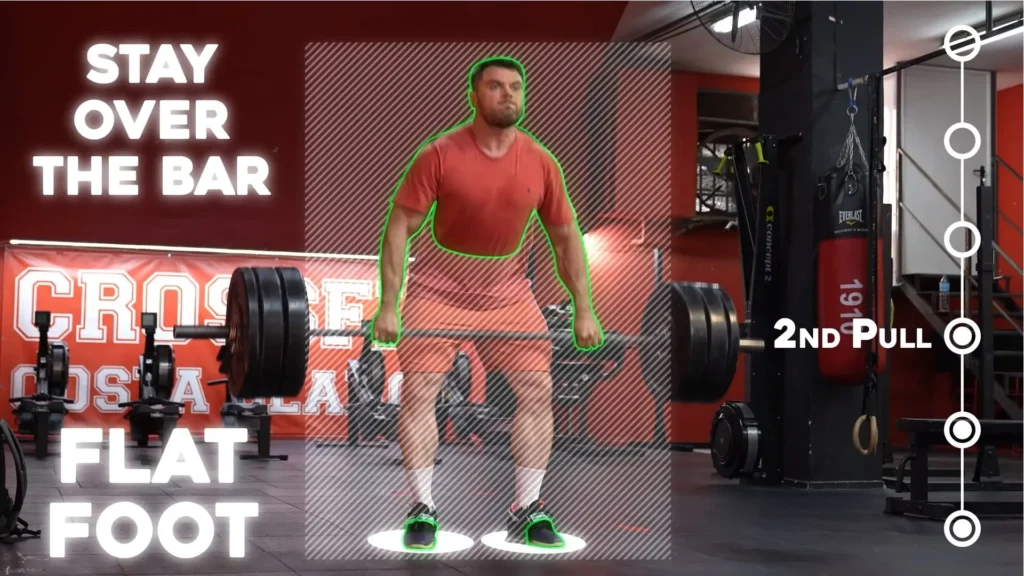
4. Turnover
(1:18-1:33 on the video above)
This is where a bar continues to move upward and you quickly move your body under the bar. Remember to keep the bar as close to your body as possible for maximum control.
The feature of this power clean phase is that an athlete tries to fix the bar as high as possible with a minimal dip. Therefore, they should direct the elbows up and rotate them around the bar while the body is in the highest position. Accompanying the bar increases its rising speed and doesn’t let it fall on the shoulders or wrists.
If an athlete has some elbow or shoulder mobility issues, they may need special exercises for the front rack mobility. Find more useful information HERE.
What angle is the best for the elbow joints? The highest possible angle till your mid-back is straight and the bar rests comfortably on the shoulders.
Where is it? It depends on the shoulder width compared to the forearm. The longer forearms you have, the lower your elbows will be. Their position varies between 3:00 and 4:00 o’clock.
So don’t worry if your elbow angle differs from other athletes. Everyone has their own position but the bar is in the same place and touches the same points.
While fixing the bar, it is important to keep the fullest possible grip to remain in contact with the bar and prevent it from rolling off the shoulders. Sometimes, athletes have too short forearms and fingers so they can’t hold the bar with the full grip. But it happens very rarely. Usually, athletes lack upper body mobility.
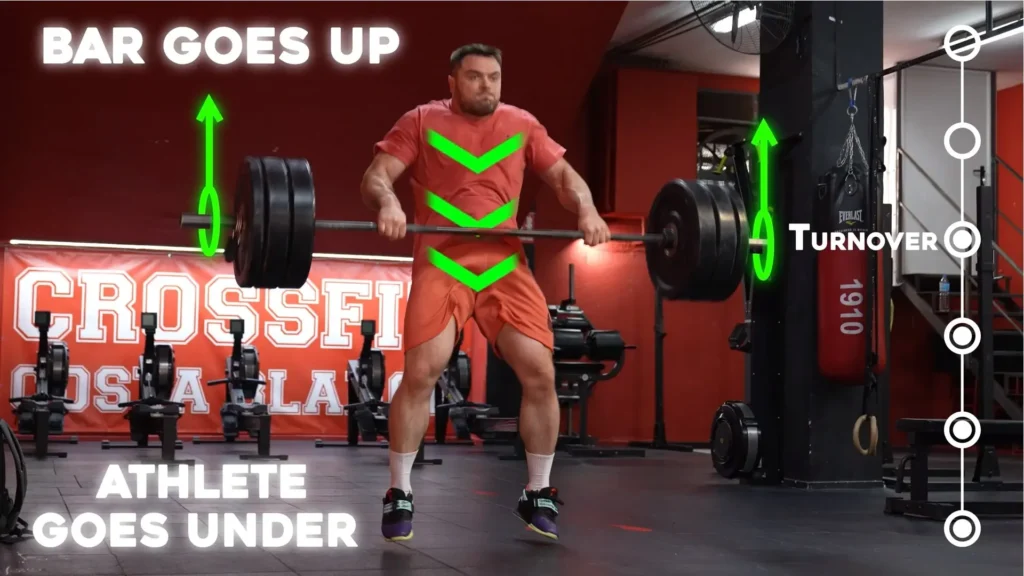
5. Catch Position
(1:33-1:50 on the video above)
Make sure your elbows are high and pointed forward. Your pelvis should be pushed back and your knees should be out. Tighten your core to stabilize your body by stretching the hip and knee joints and prepare for the final phase.
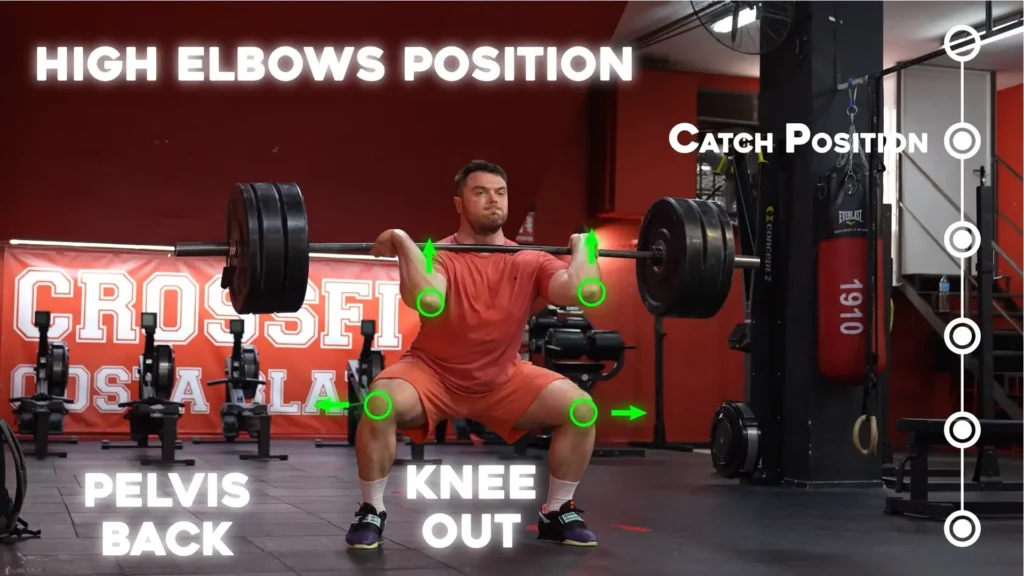
6. Recovery
(1:49-1:50 on the video above)
Stand up by extending your hips and knees. Congratulations, you have completed the Power Clean. Remember, practice makes perfect.
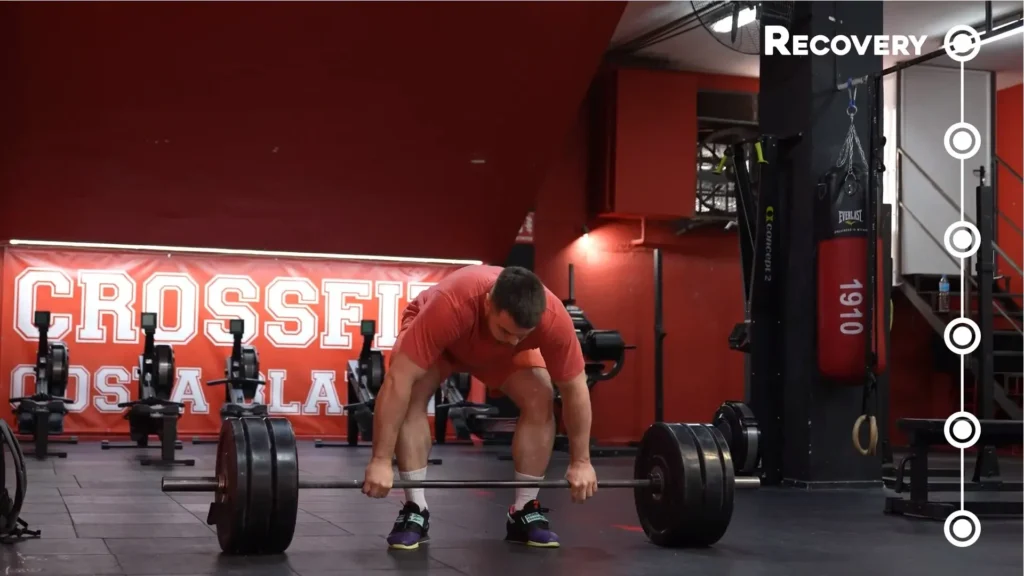
Tips on Improving the Power Clean by Oleksiy Torokhtiy
1. Wrist Warm-Up
2. Mechanics of Clean Turnover
3. Mid Thigh Clean Pull
4. Squat Clean
5. Simple Clean Progression
The Power Clean Benefits
The Power Clean is an excellent exercise for Olympic weightlifters, as it can provide a number of benefits for improving performance in the sport. Some of the key benefits of the Power Clean for Olympic weightlifters include:
1. Improved Explosiveness
The Power Clean is a highly explosive movement that requires the lifter to generate a significant amount of power in a short amount of time. This can help to improve explosiveness and speed in the snatch and clean and jerk, which are the two primary lifts in Olympic weightlifting.
2. Increased Power Output
The Power Clean is a multi-joint exercise that involves a large number of muscle groups working together in a coordinated manner. This can help to increase overall power output and strength, which can be beneficial for improving performance in the snatch and clean and jerk.
3. Enhanced Technique
The Power Clean can help to improve technique and form in Olympic weightlifting by reinforcing proper movement patterns and body mechanics. This can lead to improved performance and reduced risk of injury.
4. Improved Grip Strength
The Power Clean can be an effective exercise for building muscle mass and increasing overall strength. This can be particularly beneficial for weightlifters who need to gain weight and build muscle to compete in higher weight classes.
Overall, the Power Clean is a highly effective exercise for Olympic weightlifters, and it can provide a number of benefits for improving performance in the sport. However, it is important to learn proper technique and form and to progress gradually in weight and intensity to avoid injury.
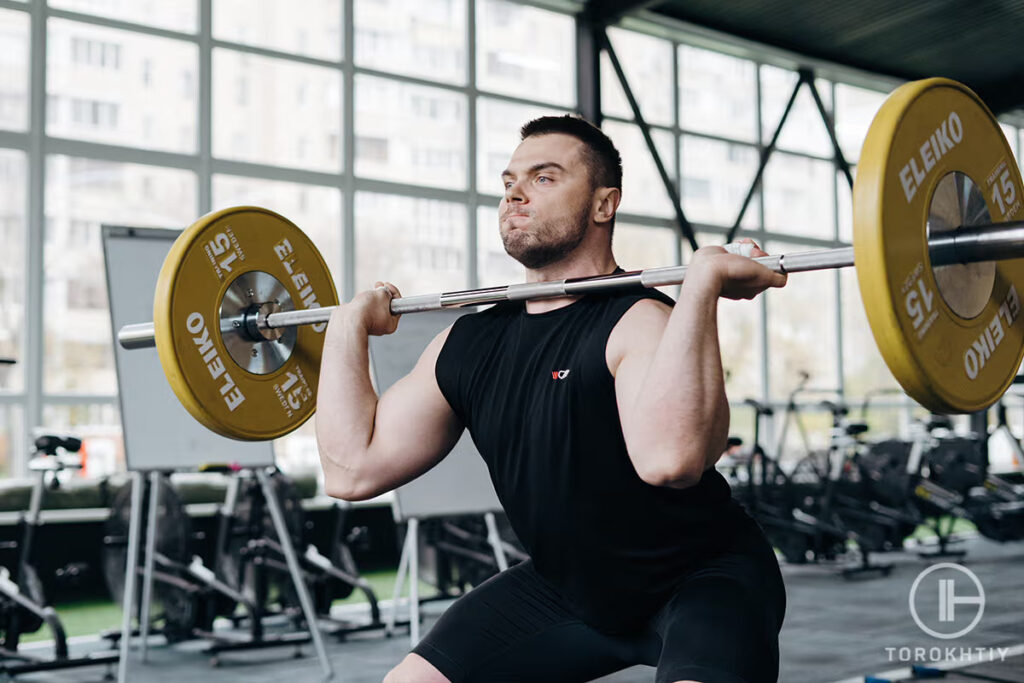
Try Our Programs To Achieve New Result
If you’d like to work more on your Clean and Power Clean, try one of our programs to improve your technique or gain new personal best.
Power Clean Training Program – 6-week training program, specially designed for athletes across different sports who aim to enhance their explosive strength and improve their performance.
🔻POWER CLEAN PROGRAM
🚀 Elevate Your Game with the POWER CLEAN Program:
- Boost explosive strength in 6 weeks.
- Enhance performance across sports.
- Three intense sessions per week for 6 weeks.
- Natural, functional movements for athletic peak.
- Achieve new results in the POWER CLEAN
- Quick results without long-term commitment.
Join today and dominate your sport!
Olympic Clean Masterclass – to level up your technique and learn how to clean perfectly.
🔻THE OLYMPIC CLEAN MASTERCLASS
🚀 Elevate Your Clean Technique with the Clean Masterclass! 🏋️♂️
Ready to enhance your Clean skills? Clean Masterclass is your path to success!
What’s Inside:
- ✅ 20 Theoretical Lessons + 60 Video Tutorials
- ✅ 12 Practical Lessons + 45 Video Demonstrations
- ✅ 90 Drills, including 30 Pro Tips
- ✅ 120 pages of elite weightlifting expertise.
Why Choose Us:
- 🥇 Expert Guidance for Athletes of All Levels.
- 📖 Learn the “What” and “Why” Behind Every Move.
- 🧠 Backed by Science for Optimal Progress.
Ready to level up your Clean technique? Join the Clean Masterclass now!
Power Clean Variations
There are several variations of the Power Clean that can be used to target different muscle groups or to modify the exercise for different fitness levels. Here are some of the most common Power Clean variations:
1. Hang Power Clean
This variation involves starting the lift from a standing position with the barbell held at hip level, rather than from the floor. This can be a useful variation for beginners who are still developing their technique and for athletes who want to focus on explosive hip extension.
2. Power Clean From Blocks
This variation involves starting the lift from a standing position with the barbell held at hip level, rather than from the floor. This can be a useful variation for beginners who are still developing their technique and for athletes who want to focus on explosive hip extension.
3. Power Clean + Front Squat
This variation involves performing a Power Clean followed immediately by a front squat, which can help to build lower body strength and stability.
4. Power Clean + Push Press
This variation involves performing a Power Clean followed immediately by a push press, which can help to develop explosive power in the upper body and to improve overall athleticism.
5. Power Clean + Jerk
This variation involves performing a Power Clean followed immediately by a split or power jerk, which is one of the two lifts in Olympic weightlifting. This can be a useful variation for athletes who want to improve their performance in weightlifting competitions.
Overall, there are many different variations of the Power Clean that can be used to target different muscle groups, to modify the exercise for different fitness levels, or to prepare for weightlifting competitions. It is important to choose the right variation for your goals and to work with a qualified coach or trainer to learn proper technique and form.
As for power clean workout, you are most likely to come across the hang power clean there – such athletes are fond of it.
Power Clean Alternatives
If you’re looking for alternative exercises to the Power Clean, here are a few options that target similar muscle groups and can provide similar benefits:
1. Hang Clean
The Hang Clean is similar to the Power Clean but starts from a standing position with the barbell held at hip level. This variation can be a good alternative if you’re having trouble with the initial pull from the floor.
2. Deadlift
The Deadlift is a classic strength exercise that targets the glutes, hamstrings, and lower back, which are also worked during the Power Clean. This exercise is great for building overall strength and can be a good alternative if you’re looking for a simpler exercise.
3. Kettlebell Swing
The Kettlebell Swing is an explosive exercise that targets the same muscles as the Power Clean but uses a kettlebell instead of a barbell. This exercise is great for improving power and athleticism.
4. Box Jumps
Box Jumps are another explosive exercise that can improve power and athleticism. This exercise targets the quads, hamstrings, and glutes, which are also worked during the Power Clean.
5. Snatch
The Snatch is another Olympic weightlifting movement that is similar to the Power Clean but involves lifting the barbell overhead in one continuous motion. This exercise can be a good alternative if you’re looking to improve your performance in weightlifting competitions.
Overall, there are many exercises that can provide similar benefits to the Power Clean. It’s important to choose exercises that fit your fitness level, goals, and equipment availability.
The Most Common Mistakes in Power Clean
The Power Clean is a complex and technical exercise that requires proper form and technique to be performed safely and effectively. Here are some common mistakes to avoid when performing the Power Clean:
❌ Tight Arms
If an athlete is too far from the bar (the projection isn’t on the mid-foot), they can’t make maximum effort in the pull and simply lose balance.
In order to avoid this mistake, don’t rush in the set-up. Get into the habit of checking all ‘controlling points’ in the starting position before every set:
– balance and bar projection on the mid-foot;
– shoulders above the knees;
– back arched;
– arms relaxed.
❌ Shrugs
When an athlete is in the explosion position and springs up, the entire body is directed vertically and the shoulders will point up on their own. There is nothing to learn, it happens naturally.
❌ Double Knee Bent
When the bar passes the knees, they bend the second time. It is also all about nature but not teaching.
❌ Not Using The Legs Enough
The Power Clean is a full-body exercise that requires the use of the legs to generate power. Failing to use the legs enough can lead to poor form and make the lift more difficult.
❌ Rounding The Back
Maintaining a straight and neutral back is crucial for performing the Power Clean safely and effectively. Rounding the back can lead to poor form and increased risk of injury.
❌ Not Using Proper Grip
Using an improper grip can make it more difficult to control the barbell and lead to decreased power output. In Olympic weightlifting athletes must use a specific type of grip – hookgrip.
❌ Failing To Explode With The Hips
The Power Clean requires an explosive extension of the hips to generate power. Failing to explode with the hips can lead to poor form and decreased power output.
❌ Allowing The Elbows To Drop
The elbows should be kept high throughout the lift to keep the bar close to the body and maintain proper form. Allowing the elbows to drop can make the lift more difficult and increase the risk of injury.
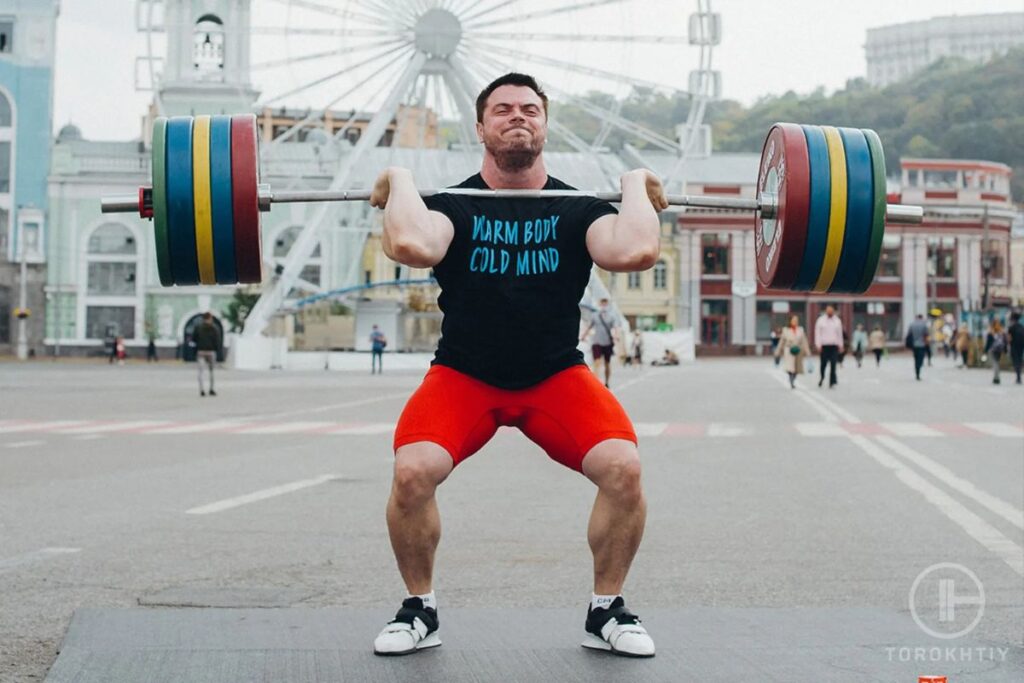
The Power Clean Programming
Programming the Power Clean into a training program depends on the individual’s fitness level, goals, and training experience. Here are some general guidelines for programming the Power Clean:
1. Warm-Up
Before starting any exercise, it’s important to properly warm up the body. A good warm-up for the Power Clean might include dynamic stretching, mobility exercises, and light cardio to increase heart rate and blood flow.
2. Frequency
The Power Clean is a high-intensity exercise that requires a significant amount of recovery time. Depending on your training experience and goals, you might perform the Power Clean once or twice a week, with at least one rest day in between.
3. Sets and Reps
The number of sets and reps you perform depends on your goals and fitness level. Beginners might start with 3-4 sets of 6-8 reps, while more experienced lifters might perform 5-6 sets of 2-4 reps. Rest time between sets should be 2-3 minutes to allow for proper recovery.
4. Weight Progression
As you become more comfortable with the Power Clean, you can gradually increase the weight you’re lifting. It’s important to progress gradually and avoid adding too much weight too quickly, as this can increase the risk of injury.
5. Technique
Proper technique is crucial for performing the Power Clean safely and effectively. It’s important to work with a qualified coach to learn proper power clean form, and to focus on maintaining it throughout each set and rep.
6. Variations
Incorporating variations of the Power Clean, as discussed earlier, can help to target different muscle groups or modify the exercise for different fitness levels. Adding variety to your training can also help to prevent boredom and increase motivation.
Overall, programming the Power Clean into a training program should be done carefully and with consideration for individual goals and fitness level.
Power clean workout routine and load can vary depending on the athlete’s level and sport. Find more interesting tips HERE.
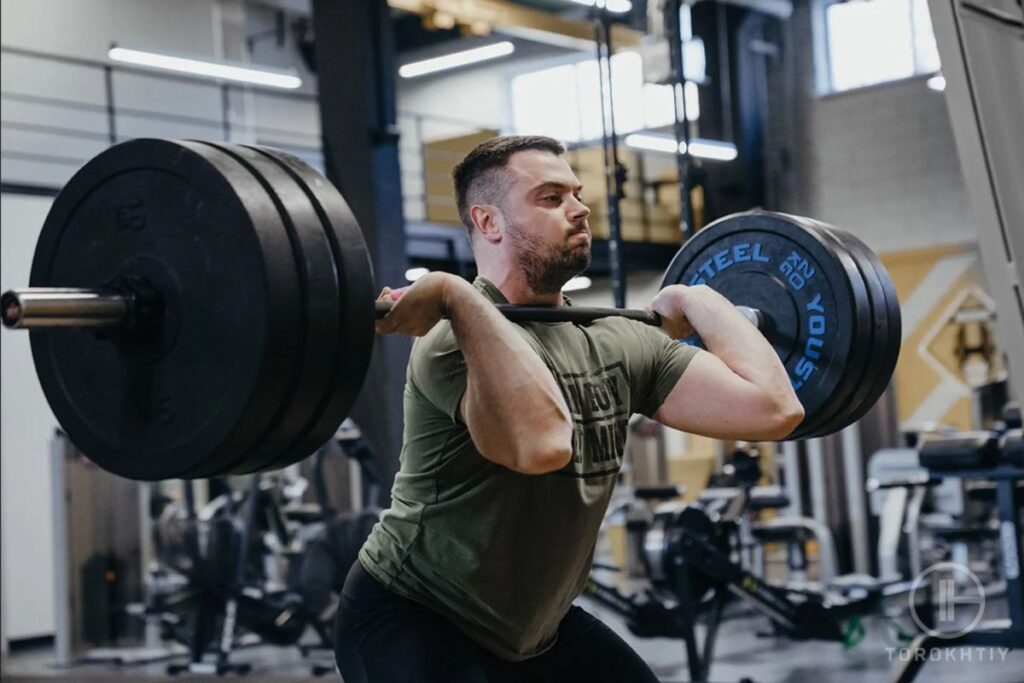
Who Should Perform Power Clean?
The Olympic power clean is a versatile exercise that can benefit a wide range of individuals, depending on their fitness goals and training experience. Here are some examples of who might benefit from incorporating the Power Clean into their training program:
1. Athletes
The Power Clean is a popular exercise among athletes, particularly those involved in sports that require explosive power and strength, such as football, basketball, and track and field.
2. Weightlifters
The Power Clean is a key exercise in Olympic weightlifting and is often used to develop explosive power and strength for the snatch and clean and jerk.
3. Strength and Power Athletes
The Power Clean is a great exercise for developing overall strength and power in the lower body, back, and shoulders. Powerlifters, strongmen, and other strength athletes can benefit from incorporating the Power Clean into their training program.
4. Fitness Enthusiasts
The Power Clean can be a challenging and effective exercise for individuals looking to improve their overall fitness level and develop full-body strength and power.
5. Rehabilitation Patients
In some cases, the power clean workout can be used as a rehabilitation for individuals recovering from injuries. However, it’s important to work with a qualified physical therapist or trainer to determine if the exercise is appropriate for your individual needs and limitations.
The Power Clean can be an excellent exercise for improving strength, power, speed, and explosiveness, and is often used by athletes in sports such as football, basketball, and track and field. However, it can be a complex movement that requires proper technique and practice to perform safely and effectively, so it is important to seek guidance from a qualified coach or trainer when learning this exercise.
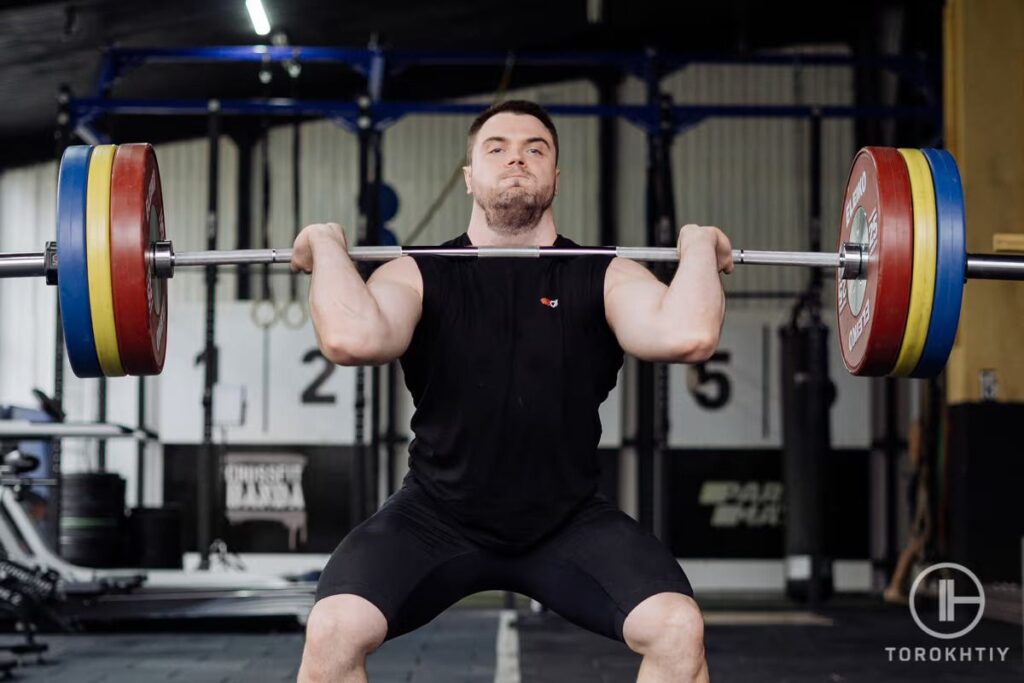
Also read:
References:
- Injury Rates and Profiles of Elite Competitive Weightlifters // NCBI: https://www.ncbi.nlm.nih.gov/pmc/articles/PMC1322916/
- Anterior shoulder instability in weight lifters // Journals: https://journals.sagepub.com/doi/epdf/10.1177/036354659302100419
- The Clean Pull and Snatch Pull // Research Gate: https://www.researchgate.net/publication/271567467_The_Clean_Pull_and_Snatch_Pull
- Grip Strength and Sports Performance in Competitive Master Weightlifters // NCBI: https://www.ncbi.nlm.nih.gov/pmc/articles/PMC9915202/
- Developing explosive power: a comparison of technique and training // NCBI: https://pubmed.ncbi.nlm.nih.gov/11339494/
- Resistance training to improve power and sports performance in adolescent athletes // JSAMS: https://www.jsams.org/article/S1440-2440(12)00035-7/fulltext
- Effects of load increase on lower extremity kinetic and kinematic variables in the back squat exercise // NCBI: https://www.ncbi.nlm.nih.gov/pmc/articles/PMC10200205/
- Effects of load increase on lower extremity kinetic and kinematic variables in the back squat exercise // NCBI: https://www.ncbi.nlm.nih.gov/pmc/articles/PMC10200205/
- The Limitations of Anterior Knee Displacement during Different Barbell Squat Techniques: A Comprehensive Review // NCBI: https://www.ncbi.nlm.nih.gov/pmc/articles/PMC10143703/
- Knee Joint Kinetics in Relation to Commonly Prescribed Squat Loads and Depths // NCBI: https://www.ncbi.nlm.nih.gov/pmc/articles/PMC4064719/
- Lower extremity muscle functions during full squats // NCBI: https://pubmed.ncbi.nlm.nih.gov/19075302/
Author: Oleksiy Torokhtiy
Olympic Weightlifting Champion
Best Results: Snatch – 200 kg,
C&J – 240 kg
Oleksiy Torokhtiy is a professional athlete boasting 20 years of experience in Olympic weightlifting. With multiple European and World titles under his belt, he has showcased his prowess in two Olympic Games (Beijing 2008 and London 2012). Upon concluding his illustrious career, Oleksiy dedicated himself to coaching. By 2022, he had conducted over 200 weightlifting seminars worldwide. He is the visionary behind an international sportswear and accessories brand known for its motto, “Warm Body Cold Mind.” Additionally, he is an esteemed author and the creator of a series of training programs and eBooks.

